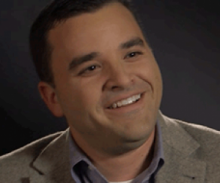A conversation with Aaron Stibel, executive vice president of Technology, Dun & Bradstreet Credibility Corp.

The Enterprisers Project (TEP): Cloud strategy is obviously evolving from the provider prospective. How is it working on the ground for you?
Stibel: We actually have SaaS solutions up and down our stack. If you think about what we had to do a few years ago, which was rebuild our entire platform, from the e-commerce websites to the products to back-office and everything in between, we couldn’t have done it without the cloud. We were a startup with a very large asset.
TEP: Were there any bumps along the way?
Stibel: At the time we went with a traditional colocation facility that was offering cloud-like solutions. It was basically a virtual private cloud, but it was apparent to us that every time we tried to light up a new server there were some very manual things going on in the background. Even that virtual private cloud was hurting the ability of our DevOps team to hit maximum velocity in putting product out. We ended up moving to Amazon Web Services (AWS), even with AWS at the time being more, because we were moving way faster than the colocation could keep up with. We just didn’t want to have a team of 20 Sys-Admins hand and feet in a colocation. And because we were able to implement true agile teams with a really great DevOps squad, our velocity was so strong that it was actually the infrastructure that was keeping us down.
TEP: So are you exclusively an AWS shop now?
Stibel: As big a solution as AWS is for us, it’s actually not our only cloud technology here. The other large partner is a telephony solution from a company called Five9. It’s important for our company because a large amount of sales and customer service is through the telephone. We have five call centers and upwards of 700 reps at some of our peak times, so phones are incredibly important to us.
When we took over the business, there was a very expensive, on-premise phone system that had a large in-house support team. There were at least two consulting companies working just to keep these phones alive, and they weren’t doing well. It was our biggest reason to look toward the cloud. We had little telephony experience. To hire a skilled telephony squad is incredibly difficult, no matter what your geography is — but even more so in Los Angeles. As we started going down this road of choosing one, I said to the consultants who were handling the RFP process for us, “I want you to delay the RFP process and put out a secondary RFP for cloud solutions.” To which they said, “You’re crazy.” Inbound telephony was mature in the cloud, but full contact center was not.
TEP: But it clearly has worked out.
Stibel: The anxiety all seems ridiculous five years later. The move was called crazy, but for me the opposite was crazier. Phones are not fun systems to operate. At least with the cloud, I’m hiring a company who does nothing but telephony. They have nothing but telephony experts that are developing these products and keeping these products online. So I ended up actually winning that battle. I also won the OPEX vs. CAPEX battle because I was able to prove that the OPEX of on-premise systems, even with the initial CAPEX, was actually more than the OPEX of the cloud solution.
TEP: Even that you do cloud out most of your infrastructure, are there still talent gaps around cloud on-premises that you are looking to fill?
Stibel: Well, of course we have SysAdmins on our team, just fewer of them because most of the work is being done by the AWS team. And I only need one person to serve as a telephony expert. I’ve always said that as much as I can remove myself from being the traditional infrastructure CTO and the more I can focus on being what I like being, which is a product CTO, the better. So when I go to sleep at night, I don’t lie awake thinking about servers. I don’t think about phones. I don’t think about most of the infrastructure stuff that the typical CTO thinks about. I think about our product roadmap and how we can squeeze more into it. And the more of this commodity stuff I can cloud out, the more of the product roadmap stuff we can squeeze in.
Aaron Stibel serves as Executive Vice President, Technology of Dun & Bradstreet Credibility Corp. Prior to Dun & Bradstreet Credibility Corp., Aaron spent nine years with software company Revenue Solutions Inc. where he co-created DiscoverTax and led technology efforts for multi-billion dollar enterprise data warehousing implementations for government agencies. He additionally led consulting and sales engagements for large-scale enterprise technology implementations ranging from $500K to $250M. Previously, Stibel was a senior technology consultant at Granitar, helping financial services clients develop eCommerce and data strategies, including implementations for Thompson Financial, MindBranch.com, Law.com, Boston.com, and NYT Companies. Stibel began his career at business consulting firm PriceWaterhouseCoopers in the Strategic Change Business Unit. He holds a BS in Computer Science from The Johns Hopkins University.




